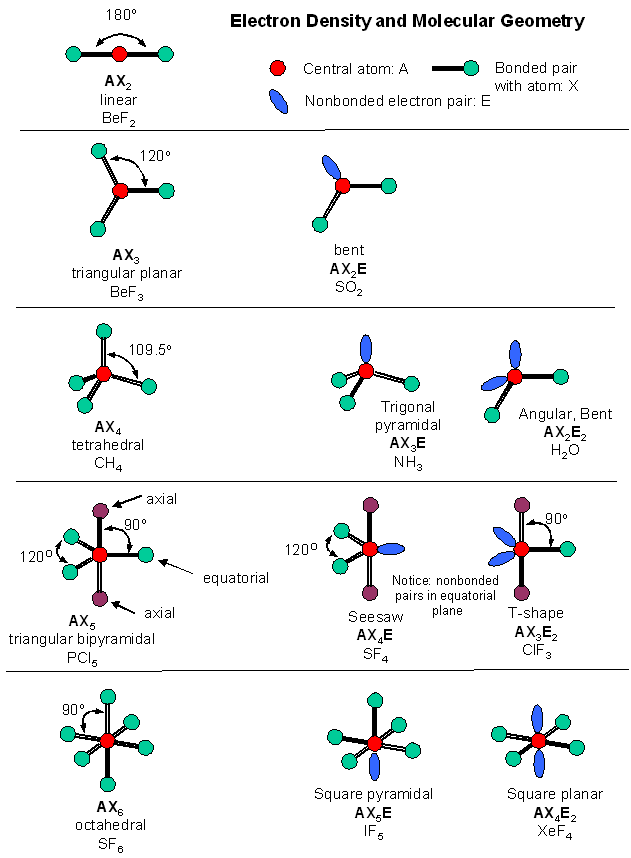Valence Shell Electron Pair Repulsion (Vsepr) Theory
In 1957
Gillespie and Nyhom gave this theory to predict and explain molecular shapes
and bond angles more exactly. The theory was developed extensively by Gillespie
as the Valence Shell Electron Pair Repulsion (VSEPR) theory. This may be
summarized as:
1. The
shape of the molecule is determined by repulsions between all of the electron
pairs present in the valence shell.
2. A
lone pair of electrons takes up more space round the central atom than a bond
pair, since the lone pair is attracted to one nucleus whilst the bond pair is
shared by two nuclei.
3. It follows that repulsion between two lone
pairs is greater than repulsion between a lone pair and a bond pair, which in
turn is greater than the repulsion between two bond pairs.
4. Thus
the presence of lone pairs on the central atom causes slight distortion of the
bond angles from the ideal shape.
5. If
the angle between a lone pair, the central atom and a bond pair is increased,
it follows that the actual bond angles between the atoms must be decreased.
6. The
order of repulsion between lone pairs and bond pairs of electrons follows the
order as:
Lone pair - lone pair repulsion > lone pair – bond
pair repulsion > bond pair – bond pair repulsion.
7. The
magnitude of repulsions between bonding pairs of electrons depends on the
electronegativity difference between the central atom and the other atoms.
8. Double
bonds cause more repulsion than single bonds, and triple bonds cause more
repulsion than a double bond.
Effect
of Lone Pairs: Molecules with four electron pairs in their outer
shell are based on a tetrahedron. In CH4 there are four bonding pairs of electrons in
the outer shell of the C atom, and the structure is a regular tetrahedron with
bond angle H – C – H of 109°28’. In NH3 and N atom has four electron pairs in the
outer shell, made up of three bond pairs and one lone pair.
Because of the lone pair, the bond angle H – N – H
is reduced from the theoretical tetrahedral angle of 109°28’ to 107°28’.
In H2O the O atom
has four electron pairs in the outer shell.
The shape of the H2O molecule is based on a tetrahedron
with two corners occupied by bond pairs and the other two corners occupied by
lone pairs.
The presence of two lone pairs reduces the bond angle
further to 104°27’.
In a similar way, SF6 has six bond pairs in the outer shell and is a
regular octahedron with bond angles of exactly 90°.
In BrF5, the Br also
has six outer pairs of electrons, made up of five bond pairs and one lone pair.
The lone pair reduces the bond angles to 84°30’.
Whilst it might be expected
that two lone pairs would distort the bond angles in an octahedral as in XeF4 but it isnot so.
Actual bond angle is 90°,
reason being that the lone pairs are trans to each other in the octahedron, and
hence the atoms have a regular square planar arrangement.
Molecules with five pairs of electrons
are all based on a trigonal bipyramid.
Lone pairs distort the structures as
before.
The
lone pairs always occupy the equatorial positions (in an triangle), rather than
the axial positions (up and down).
Thus in I3– ion, the central I atom has five
electron pairs in the outer shell, made of two bond pairs and three lone pairs.
The lone pairs occupy all three equatorial positions and the three atoms occupy
the top, middle, and bottom positions in the trigonal bipyramid, thus giving a
linear arrangement with a bond angle of exactly 180°.
Effect of Electronegativity: NF3 and NH3
both have structures based on a tetrahedron with one corner occupied by a lone
pair.
The high electronegativity of F push the bonding electrons further away
from N than in NH3.
Hence the lone pair in NF3 causes a greater distortion from
tetrahedral and gives a F – N – F bond angle of 102°30’, compared with 107°48’
in NH3.
The same effect is found in H2O (bond angle 104°27’) and F2O (bond
angle 102°).




No comments:
Post a Comment